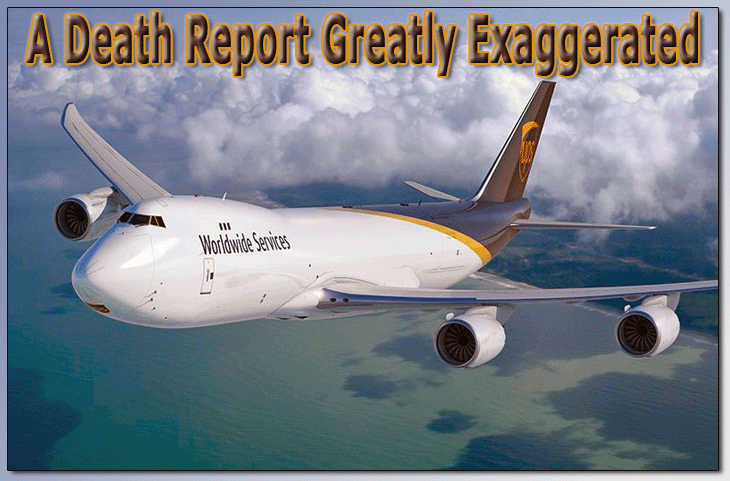
We
paraphrased our headline from the famous Mark Twain,
but given recent news from Boeing, the sentiment stands.
Editorial aviation writers around the world were wearing
egg on their collective faces as this bright, new week
dawned. The recent declaration announcing the end of
the B747 was spoken too soon. Boeing has pulled an 11th
hour comeback, landing a 14-aircraft order from UPS
and thus extending the production life of the airplane
that taught the modern world to fly, the venerable B747.
There were only six
B747 aircraft to go on the last production line. At
half an airplane a month, the death rattle of the B747
was due for sometime next year.
Well, forget all
of that and good for Boeing. There is certainly space
in the world for what is arguably the greatest airplane
of all time.
Long live the spirit
of the airplane that will not die, the quite lovely
B747.
UPS
offered the air freight industry plenty of cause for
confidence ahead of the traditional peak season. After
posting impressive profit and revenue figures for Q3
on October 27, Big Brown added to the good vibes by
forecasting a record Black Friday-New Year holiday season,
and then announcing an order for 14 new Boeing 747-8
jumbo freighters.
The freighter order,
UPS’s first since 2013, was a sign of faith both
in the expected tonnage growth through its domestic
and international networks and recognition that more
capacity is needed during peak season. Amazon’s
move into logistics fulfillment and in-house air freight
operations has made that fact eminently clear.
But hidden within UPS’s
financials was the revelation that the company’s
Supply Chain and Freight Division had struggled with
a “weak” international air freight forwarding
market in Q3, although its North American air freight
business fared better.
UPS’s international
air freight performance surprised many following on,
as it did, from the general spate of positive market
indicators for Q3. HKIA, generally a reliable bellwether
for freight markets, saw robust growth of 7.2 percent
year-on-year in September as monthly volumes at the
world’s leading freight hub reached 394,000 tons.
Transshipment traffic, which increased 15 percent compared
to a year earlier, drove throughput, while volume to
and from key trading regions in North America and Southeast
Asia increased significantly.
The Association of Asia
Pacific Airlines (AAPA) also reported a further uptick
in air cargo markets last month as demand grew 5.3 percent
measured in freight ton kilometers.
“Air cargo volumes
aggregated for the first nine months of the year match
those of the same period last year, reflecting the modest
upswing in demand in recent months, bolstered by higher
shipments of electronics designated for product launches,”
said Andrew Herdman, AAPA Director General.
Rewind a month and IATA’s
global analysis reported that August volumes had also
been strong with demand, measured in freight tonne kilometers
(FTKs), up 3.9 percent year-on-year. Carriers in all
regions except Latin America reported an increase in
year-on-year demand in the month, while North American
carriers posted a 5.5 percent surge.
Pricing has also been
on the up. After gains in August, Drewry’s East-West
Airfreight Price Index continued to climb in September,
up 4.4 points in the month, the second largest gain
this year.
The Index, a weighted
average of all-in airfreight “buy rates”
forwarders paid to airlines for standard deferred airport-to-airport
airfreight services on 21 major East-West routes for
cargoes above 1,000 kg, reached 91.9 in September, equivalent
to an all-in buy rate of $2.98 per kilo. Although still
behind the 97.2 reached in September 2015, the reading
was the highest recorded this year.
“While this is
undoubtedly good news for sellers, the rate remains
considerably below that of last September, which was
$3.15, or 97.2 points,” said Drewry.
“It is the only
September since Drewry began reporting on airfreight
rates in 2012 that the rate has fallen below $3.00.”
Which probably explains
UPS’s international air freight travails.
SkyKing |





